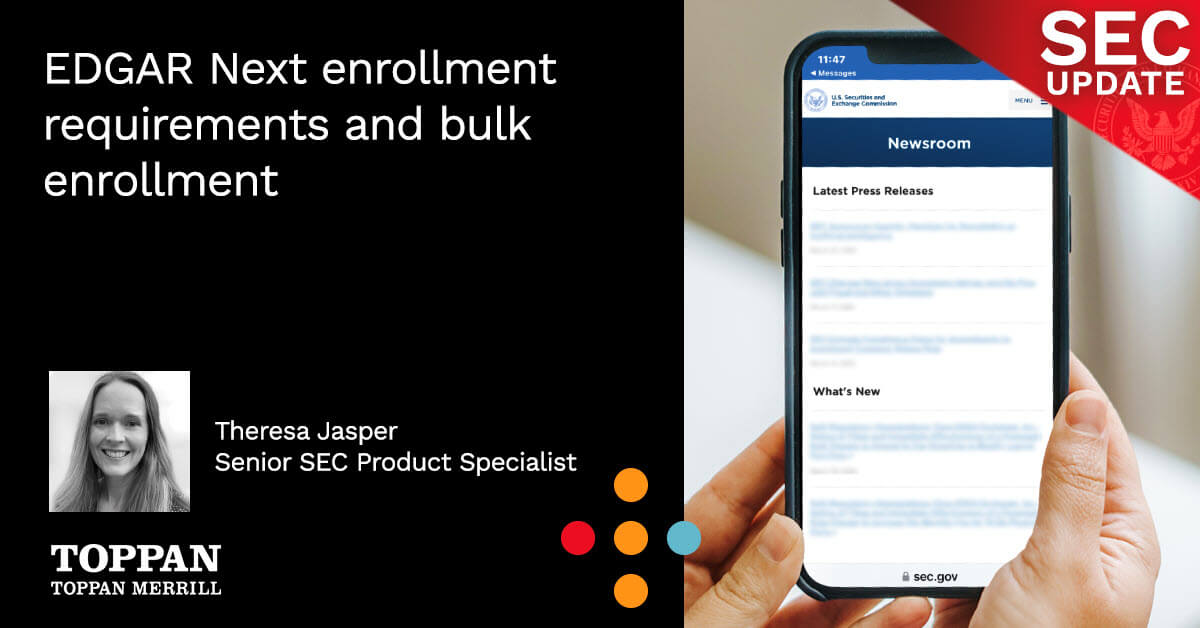Changing a company’s name is a big deal. From a legal standpoint, there’s so much more to do than you would think. It’s expensive – and time-consuming – to pull off.
Man, we don’t envy those of you who have been through the process of a public company changing its name. The legal workload is a bear.
You start with all the state law filings. Not just the state where you’re incorporated, but you need to reserve and maintain the new name in other states as well. You need to handle the actual name change, amending your DBAs, amending your qualifications to do business. You might be doing this in multiples too if your subsidiaries change their names as well.
You’ll probably change the name for all of your employee plans, all your policies, revising all the standard stuff you deal with regularly – like the employee handbook and employment agreements. And we won’t get into all the other legal stuff, like the IP stuff, such as trademarks. The list goes on and on.
Here are seven things to consider, from threshold matters like shareholder approval to the nitty gritty of updating the EDGAR database:
- Shareholder approval may be necessary
You’ll need to decide how you structure the “deal” to pull off the name change. If you merge with a shell corporation – or not. The structure matters because it will help determine whether you need to obtain shareholder approval for the name change.
To figure out what you’re required to do, you’ll need to research the state laws where your company is incorporated, check your articles of incorporation and bylaws too.
If state law permits, you may be able to forego shareholder approval by simply amending your charter. You might be incorporating a new wholly-owned subsidiary, doing a short form merger with it – with the parent as the surviving company – and then filing a certificate of merger specifying the new name.
Having said that, note that Delaware law was amended in 2014 to permit boards to amend the corporate name without shareholder approval, and corporate laws in many MBCA states (such as Washington) have had the same provision for a long time as well. There are still some companies that use the subsidiary approach, but a simple charter amendment is frequently sufficient.
But some companies do obtain shareholder approval. It should be a non-controversial item on the ballot for your next annual shareholder’s meeting.
You could hold a special meeting of shareholders to approve it – but that would make changing the name even more expensive.
If you do seek shareholder approval, you won’t need to file a preliminary proxy statement for a name change. The SEC Staff has this CDI – some informal guidance that says you can go straight to filing a definitive proxy statement instead:
Question 126.02
- Question: Is a registrant required to file a preliminary proxy statement in connection with a proposed corporate name change to be submitted for security holder approval at the annual meeting?
- Answer: No. As set forth in Release No. 34-25217 (Dec. 21, 1987), the underlying purpose of the exclusions from the preliminary proxy filing requirement is “to relieve registrants and the Commission of unnecessary administrative burdens and preparation and processing costs associated with the filing and processing of proxy material that is currently subject to selective review procedures, but ordinarily is not selected for review in preliminary form.” Consistent with this purpose, a change in the registrant’s name, by itself, does not require the filing of a preliminary proxy statement. [May 11, 2018]
2. Consider CUSIP numbers and stock symbol for the cover pages of your SEC filings
You’ll need to get two things taken care of before you’re ready to make the name change – so that you can change these things on the cover of your SEC filings when you’re ready to push the button on the name change.
Historically, new CUSIP numbers were required for equity securities following a corporate name change. However, in 2021, CUSIP Global Services (CGS) introduced CUSIP Permanence, which allows companies to retain CUSIP numbers for equity and debt securities in the event of a name change. The same goes for ISIN’s assigned by CGS, but note that ISIN’s assigned by other national numbering agencies may have different procedures for name changes and you should contact them to confirm any specific procedures.
You may also want a new ticker symbol for your stock to reflect the new name – it’s not required but some companies do that. If it’s desired, you’ll be working with the stock exchange on which your stock is listed, calling your specialist to see what symbols are available – and then filing a subsequent listing application with the exchange to make the change.
3. Update name on the SEC’s EDGAR database
While easy to overlook, you’ll need to change the company’s name on the SEC’s EDGAR database. You need to go to the SEC’s “Maintain and update company information” page and jump down to the “Editing company information” section and follow the detailed steps to make the address change.
You’ll make the request for this online through the EDGAR Filing Website or the OnlineForms Management Website. Your company name change must be reviewed and approved by the SEC’s EDGAR Staff, which can take a few days. So, bake that into your timeline.
Once accepted by the SEC staff, the updated name won’t appear on EDGAR until you make your first filing subsequent to that. After you do make that first subsequent filing, when people search EDGAR using your old name, the new name will pop up.
Note that your old company name will show up at the top of your company’s filing history on EDGAR after the name changes. For example, see the two former names listed beneath this company’s name on its EDGAR page.
4. File a Form 8-K with amended charter and bylaws and press release
Then you’ll file a Form 8-K under Item 5.03 with your amended bylaws and articles of incorporation. That 8-K may include the press release you issued announcing the name change under Item 7.01 (while not required, most companies issue a press release). Here is an example.
Item 601(b)(3) of Regulation S-K says that if you amend your articles and bylaws, the 8-K can include just the amendment parts of those – you don’t have to include the complete charter and bylaws as revised. However, many companies include the full charter and bylaws.
As for the timing of when you file the 8-K, the filing obligation is triggered when you “amend the articles of incorporation.” You can file the 8-K soon after you issue your press release, you don’t have to wait for the amended articles to be effective in the state where you filed them. A lot of state laws have a lag between the time the amended articles are filed with the state and the date that the amendment is deemed effective.
It also depends on what type of service you request from the state office when you make the filing and how you draft the certificate of amendment. Many companies opt to announce the change in advance of it being effective.
5. Subsequent filings should have new name on the cover
All of your SEC filings going forward should reflect new name on the cover page. Forms 8-K and 10-Q require a line on the cover noting the company’s former name, if changed since the last report. Some companies list their former name on the covers of their SEC filings until the first Form 10-K filed since the name change.
6. Update your ’34 Act exhibits
If the company amends any agreements or contracts that were previously filed as a material contract exhibit, Item 601(a)(4) technically requires those amendments – even though they’re immaterial amendments – to be filed as an exhibit to the company’s periodic reports. But in practice, some companies just leave those exhibits as they are and don’t hassle with this.
However, we wouldn’t have this cavalier attitude with your amended articles of incorporation and bylaws. Item 601(b)(3) says that if you amend your articles and bylaws, you need to file a complete copy with the next periodic report.
In fact, Regulation S-K CDI Interpretation 246.01 drives this point home. It states: “Item 601(b)(3) requires that the entire amended text of the articles or by-laws be filed, along with the text of the new amendments. This could be accomplished by filing the entire amended text, redlined to show the new amendments.”
Whether you file the text of only the amendments on the 8-K, a redlined version showing the amendments, or the amendments plus a complete copy of the documents, as amended, you should be sure to include the entire set of revised charter & bylaws as exhibits on the next periodic report.
7. Consider whether you need to amend your Form S-3s & S-8s
Let’s talk about whether you need to file new or amend outstanding Form S-3s and S-8s for changes to the names of your plans. Many companies file a new Form S-3 for things like a DRIP if they have one – and a new Form S-8 for things like a company stock fund in the 401(k) plan – even though they already have filed that 8-K for the name change. Whether you need to do this depends on how the name change was accomplished.
If you did the name change through a charter amendment, then a new registration statement isn’t necessary. If you did the name change through a merger, then you are likely dealing with a new issuer and would need to file a new registration statement. Then you might need a new S-3 or S-8.
Assuming you met the criteria in Rule 414 – a ’33 Act rule regarding successor issuers – you could also file post-effective amendments to existing registration statements.
If your analysis shows you don’t have to file new registration statements, you don’t have to do anything to your existing S-3s and S-8s – assuming you filed that 8-K when you changed the name – and you don’t have to file a post-effective amendment if you don’t want to.
But the next time you did file a post-effective amendment, you would use the company’s new name on it. And even though you haven’t filed a post-effective amendment, you should change the company’s name on the prospectus that you distribute to employees. Otherwise, that may be confusing to them if it had the old company name.
View source (for all formatting, tables, footnotes, etc.) >>
Ben Dale is an associate in the Corporate & Securities practice at Perkins Coie. He has experience representing issuers and underwriters in domestic and cross-border capital markets transactions including securities offerings, consent solicitations, and redemptions. Ben also advises companies on corporate transactional matters, corporate governance, and securities regulations.



